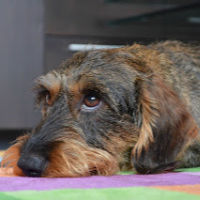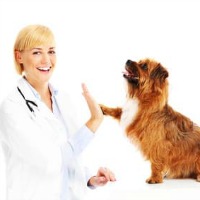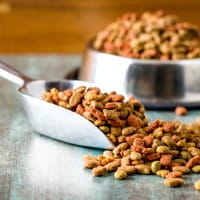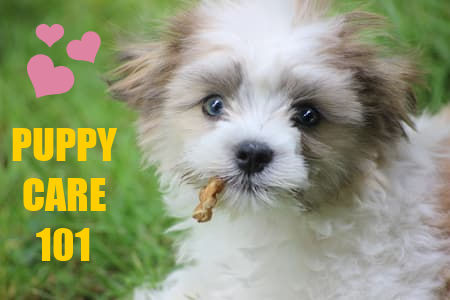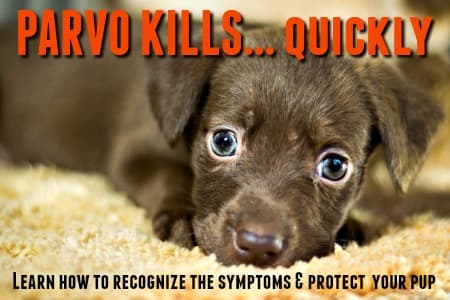FYI: If you buy something through a link on this site I may earn a commission - at NO extra cost to you.
Dog Bloat
Dog bloat is an extremely dangerous, often deadly, condition which usually comes on very suddenly and progresses with lightning speed.
Canine Bloat is also known as Gastric Dilatation Volvulus (GDV) or Gastric Torsion.
Being 'bloated' doesn't mean the same thing to dogs as it does to humans. We can be bloated, but not in danger. Bloat in dogs is very dangerous, and somewhat similar to Colic in horses.
The medical dictionary definitions of these three words describe what happens when a dog has bloat.
- Gastric - means 'of the stomach'
- Dilatation - means 'to dilate or become wider'
- Volvulus - means 'abnormal twisting of gastrointestinal tract'
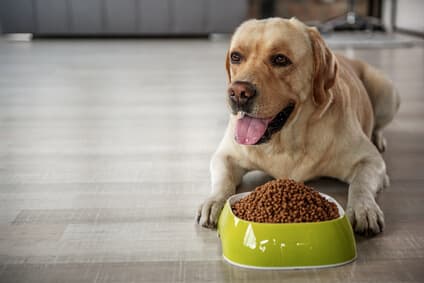
Basically what happens in bloat is that your dog's stomach becomes both filled with gas and twisted/rotated cutting off blood supply and any escape for the stomach contents/gases.
Risk Factors for Bloat in Dogs
Although experts can't give us one specific cause of bloat, there are certain risk factors that increase your dog's odds of experiencing it.
Risk factors for bloat in dogs include:
- Being a large or giant breed
- Having a deep chest in relation to body shape
- Being male
- Being middle-aged rather than a puppy or senior
- Having and anxious, highly-strung personality
- Eating a lot of food, or being a 'greedy' eater
- Drinking lots of water quickly
- Exercising vigorously right before/after eating and/or drinking
- A family history of bloat in relatives
- Eating a low quality diet
Although these can increase the odds of dog bloat happening, it can also occur without ANY of the above risk factors being in place.
Certain dog breeds also seem to have a higher risk of developing bloat. These breeds include:
- Akitas
- Alaskan Malamutes
- Basset Hounds
- Boxers
- Cane Corsi
- Chows
- Doberman Pinschers
- Golden Retrievers
- Gordon Setters
- German Shepherds
- German Shorthair Pointers
- Great Danes
- Greyhounds
- Irish Setters
- Irish Wolfhounds
- Labrador Retrievers
- Newfoundlands
- Old English Sheepdogs
- Rottweilers
- Saint Bernards
- Standard Poodles
- Weimeraners
But NO breed is safe from bloat and it can happen to a dog of any size, sex, age, or breed.
Immediate, emergency, veterinary care is a dog's only hope of survival and release from the excruciating pain GDV causes.
You can't 'wait-and-see', or take time to make an appointment.
Although this condition is so dangerous, it's also one that many dog owners are not aware of, or able to recognize the symptoms of, quickly enough.
Dog Bloat Symptoms
The symptoms of canine bloat usually appear suddenly, and escalate quickly.

What makes things worse is that the signs your dog may have bloat or torsion can be vague, and may not appear too serious unless you're aware that the condition exists... and what to look out for.
Common dog bloat symptoms include:
- A bloated or swollen belly (not always obvious)
- Excessive drooling
- Unsuccessful vomiting (except possibly saliva/mucus)
- Pacing and restlessness
- Panting
- Whining, crying or moaning
- Seeming unable to get comfortable
- Breathing difficulties
- Rapid or erratic heart rate
- Difficulty moving around
- Standing in an unusual postion
- Collapse
Also, if your dog has bloat he is going to be feeling very ill and this often means he will search you out, try to stay close to you, be clingy or just acting out of character, for him.
Treating Dog Bloat
There are absolutely no home-remedies or anything YOU can do for your dog if he has bloat, and without help he will die.
The ONLY thing that gives him a chance of surviving is to get him to a veterinarian immediately.
If it's after hours/weekend/national holiday then you need to find the closest 24 hour or emergency animal clinic and take him there.
I'd strongly recommend calling the veterinary clinic you are going to be taking your dog to once your on your way (or make a quick call beforehand if you need to focus on your dog as you drive). That way they will be prepared for what he needs.
What you can do is to keep your dog as calm as possible to help reduce the risk of shock setting in.
Although over-the-counter anti-gas product called Phazyme is used by some experienced owners whose dogs are in high-risk categories for canine bloat. Giving Phazyme caplets can help disperse gas, but if there is torsion (twisting) of the stomach it can't be released so there's really no benefit.
Unfortunately you can't tell whether there's torsion or not, only X-rays will show that, plust here could be complications or distress if you try to force tablets into your dog while he's already in pain. Surgery is the only way to treat dog bloat.
During surgery your dog's stomach and intestines will be gently untwisted and a procedure called a Gastropexy done to prevent the condition recurring.
Sometimes the spleen has been involved in the torsion, and if that's the case it may need to be removed at the same time.
Although surgery doesn't guarantee that your dog will survive an episode of bloat, it is his only chance. Statistics show that as many as 85% of dogs who are diagnosed and treated quickly go on to make a full recovery within a few weeks.
However, for dogs who aren't diagnosed or treated early enough, or who don't get the treatment they need, mortality statistics are heart-breakingly high.
Preventing Dog Bloat
There are also no guaranteed ways to protect your dog from developing bloat, but there are some things you can do to minimize the risks.
Help to reduce your dog's chances of getting dog bloat by:
Changing his eating habits
Studies have shown that eating several smaller meals rather than one large one is better.
Eating two or three times a day is better for Fido's digestive system.
Don't allow your dog to eat too fast. Some dogs are chow-hounds and seem to inhale their food, this is dangerous.
If your dog is a 'guzzler' try a go-slow dog bowl like the Brake-Fast dog bowl or the Outward Hound Slow Feed dog bowl.
You may have heard that elevated dog bowls can help prevent bloat but current opinion on this is divided.
Keep dog meal-times as stress free and low key as possible.
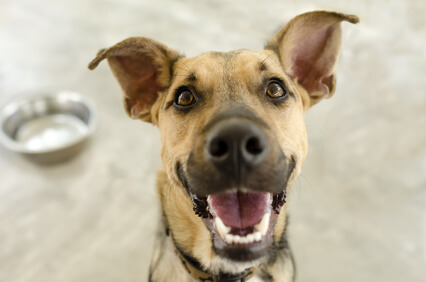
If Fido gets anxious or stressed when eating around other dogs and tries to gobble up his food or is always trying to protect his bowl, let him eat separately so that he can relax.
In general, eating in a quiet spot out of the way of the hustle and bustle and noise of the home is the best choice for your dog's mealtimes.
Try to give Fido 10 minutes or so between eating and drinking, and make sure he doesn't drink his water too fast.
Keep the water level in his bowl lower if it helps and just top it up as necessary. He absolutely needs to have all the water he wants, just not be allowed to guzzle it down too quickly.
Feeding the right diet
Be sure to only feed a premium dog food (see 10 best dog food brands here) and avoid formulas which are high in carbohydrates, have fats/oils in the first four ingredients.
Carbohydrates are involved in the excessive production of gas, which is one of the key elements of bloat in dogs.
Law doesn't require dog food manufacturers to list the percentage of carbs in their formulas, but you can estimate it for yourself.... Protein, fat and moisture percentages do have to be disclosed and all dog foods contain ash, on average ash accounts for about 6% of the total.
So, all you need to do is add together the percentages of protein, fat and moisture and then add on another 6% for ash. Then subtract that from 100%. The figure you arrive at is approximately what percentage of carbs are in the dog food you're looking at.
Anything over 50% could be considered high in this instance, and low-carb is best, so look for 15 - 30% if possible.
Adding probiotics (such as Vetri Mega Probiotics or Proviable DC) or digestive enzymes (like Total-Zymes powder) to Fido's diet can help keep his gastrointestinal tract healthy and working optimally. This may help prevent the excessive gas which plays such a major role in canine bloat.
Separate eating/drinking and exercise times
Vigorous exercise or activity immediately before, or immediately after, eating or drinking is one of the risk factors for dog bloat.
So, make sure there are at least 30 minutes to an hour between any food or water and Fido's exercise or play times.
I hope this article has helped you to become aware of the dangers of dog bloat and to know how to recognize the signs that your dog may be affected.
Taking the steps to minimize his risk of ever getting bloat could be a life-saver for him, especially if your Fido is in any of the 'at risk' categories.
And finally.... if your dog is showing any of symptoms listed on this page and you're concerned, please don't wait, get him to veterinary help immediately.
you might also like...
- Home
- Dog Health Information
- Dog Bloat
FTC Disclosure: Some pages on this site contain affiliate links. I may earn on qualified purchases.
